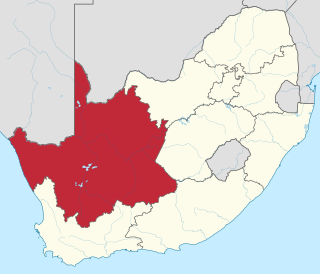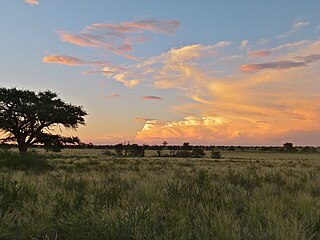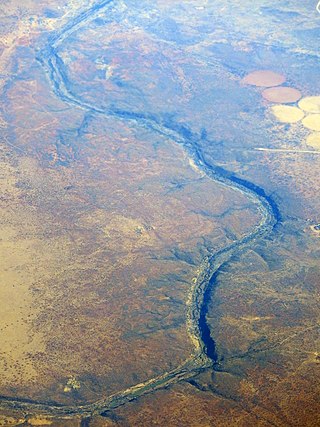Related Research Articles

A petroglyph is an image created by removing part of a rock surface by incising, picking, carving, or abrading, as a form of rock art. Outside North America, scholars often use terms such as "carving", "engraving", or other descriptions of the technique to refer to such images. Petroglyphs, estimated to be 20,000 years old are classified as protected monuments and have been added to the tentative list of UNESCO's World Heritage Sites. Petroglyphs are found worldwide, and are often associated with prehistoric peoples. The word comes from the Greek prefix petro-, from πέτρα petra meaning "stone", and γλύφω glýphō meaning "carve", and was originally coined in French as pétroglyphe.

The Northern Cape is the largest and most sparsely populated province of South Africa. It was created in 1994 when the Cape Province was split up. Its capital is Kimberley. It includes the Kalahari Gemsbok National Park, part of the Kgalagadi Transfrontier Park and an international park shared with Botswana. It also includes the Augrabies Falls and the diamond mining regions in Kimberley and Alexander Bay.

In archaeology, rock arts are human-made markings placed on natural surfaces, typically vertical stone surfaces. A high proportion of surviving historic and prehistoric rock art is found in caves or partly enclosed rock shelters; this type also may be called cave art or parietal art. A global phenomenon, rock art is found in many culturally diverse regions of the world. It has been produced in many contexts throughout human history. In terms of technique, the four main groups are:

The McGregor Museum in Kimberley, South Africa, originally known as the Alexander McGregor Memorial Museum, is a multidisciplinary museum which serves Kimberley and the Northern Cape, established in 1907.

James David Lewis-Williams is a South African archaeologist. He is best known for his research on southern African San (Bushmen) rock art. He is the founder and previous director of the Rock Art Research Institute and is currently professor emeritus of cognitive archaeology at the University of the Witwatersrand (WITS).
The Matsieng Footprints are natural engravings found in southern Botswana. The site contains up to 117 engravings and three natural rock-holes, dating back between 3,000 to 10,000 years. Many of the footprints are human or feline-like in design.

The ǀXam and ǂKhomani heartland World Heritage Site consists of regions located to the South and North of Upington, respectively, in the Northern Cape Province of South Africa. The ǀXam and ǂKhomani people were linguistically related groups of San (Bushman) people, their respective languages being part of the ǃKwi language group. Descendants of both the ǀXam and Nǁnǂe include Afrikaans-speaking ‘Coloured’ people on farms or in towns in the region amongst whom the precolonial languages are either entirely extinct or can be spoken by but a very few people.

Plooysburg is a small town about 70 km west of Kimberley, Northern Cape, South Africa. It is situated close to the Riet River. The town took it's name from the Du Plooy family, one of the original famlies of white selttlers. With a church, school, police station and shop it serves a local farming and farm-worker community. Nearby is the rock art site of Driekops Eiland, and the Mokala National Park.

The Riet River is a westward-flowing tributary of the Vaal River in central South Africa. In precolonial times the Riet was known as the Gama-!ab, a !Kora name meaning 'muddy'. Its main tributary is the Modder River and after the confluence the Riet River flows westwards to meet the Vaal.
Wildebeest Kuil Rock Art Centre is a rock engraving site with visitor centre on land owned by the !Xun and Khwe San situated about 16 km from Kimberley, Northern Cape, South Africa. It is a declared Provincial Heritage Site managed by the Northern Cape Rock Art Trust in association with the McGregor Museum. The engravings exemplify one of the forms often referred to as ‘Bushman rock art' – or Khoe-San rock art – with the rock paintings of the Drakensberg, Cederberg and other regions of South Africa being generally better known occurrences. Differing in technique, the engravings have many features in common with rock paintings. A greater emphasis on large mammals such as elephant, rhino and hippo, in addition to eland, and an often reduced concern with depicting the human form set the engravings apart from the paintings of the sub-continent.
Wonderwerk Cave is an archaeological site, formed originally as an ancient solution cavity in dolomite rocks of the Kuruman Hills, situated between Danielskuil and Kuruman in the Northern Cape Province, South Africa. It is a National Heritage Site, managed as a satellite of the McGregor Museum in Kimberley. Geologically, hillside erosion exposed the northern end of the cavity, which extends horizontally for about 140 m (460 ft) into the base of a hill. Accumulated deposits inside the cave, up to 7 m (23 ft) in-depth, reflect natural sedimentation processes such as water and wind deposition as well as the activities of animals, birds, and human ancestors over some 2 million years. The site has been studied and excavated by archaeologists since the 1940s and research here generates important insights into human history in the subcontinent of Southern Africa. Evidence within Wonderwerk cave has been called the oldest controlled fire. Wonderwerk means "miracle" in the Afrikaans language.
The concept of the Northern Cape as a distinct geo-political region of South Africa coalesced in the 1940s when a "Northern Cape and Adjoining Areas Regional Development Association" was formed and the first map featuring the name "Northern Cape" was published. The geographic spread to which the term applied was not fixed until 1994, however, when it attained precise definition as the Northern Cape Province, one of South Africa's nine post-apartheid provinces. Since then there have been boundary adjustments to include parts of the former Bophuthatswana adjacent to Kuruman and Hartswater. Vryburg and Mafikeng, in the north eastern extremity of the former Cape Province - and hence regarded as part of the pre-1994 "Northern Cape" - are excluded, being part, now, of the North West Province in the North.
Kousop, birth date unknown, killed in a battle at Slypklip, Vaal River, near Kimberley, Northern Cape, South Africa, on 6 July 1858, was the leader of a group of San or Khoe-San who inhabited the area between the Modder, Riet and Vaal Rivers, western Orange Free State, in the mid nineteenth century.

The Nooitgedacht Glacial Pavements comprise a geological feature between Kimberley and Barkly West, South Africa, pertaining to the Palaeozoic-age Dwyka Ice Age, or Karoo Ice Age, where the glacially scoured ancient bedrock was used, substantially more recently, during the Later Stone Age period in the late Holocene as panels for rock engravings.
Eiland is a surname. Notable people with the surname include:

The San, or Bushmen, are indigenous people in Southern Africa particularly in what is now South Africa and Botswana. Their ancient rock paintings and carvings are found in caves and on rock shelters. The artwork depicts non-human beings, hunters, and half-human half-animal hybrids. The half-human hybrids are believed to be medicine men or healers involved in a healing dance. Gall writes, "The Laurens van der Post panel at Tsodilo is one of the most famous rock paintings." High on this rock face in Botswana is the image of a "magnificent red eland bull" painted, according to Van der Post, "only as a Bushman who had a deep identification with the eland could have painted him." Also on this rock face is a female giraffe that is motionless, as if alarmed by a predator. Several other images of animals are depicted there, along with the flesh blood-red handprints that are the signature of the unknown artist. The Drakensberg and Lesotho are particularly well known for their San rock art. Tsodilo was recognised as a UNESCO World Heritage Site in 2001; not all the art covered by this is by San people or their ancestors.
The San religion is the traditional religion and mythology of the San people. It is poorly attested due to their interactions with Christianity.
The Northern Cape Heritage Resources Authority, previously called Ngwao Boswa jwa Kapa Bokone, and commonly known as 'Boswa', is a provincial heritage resources authority established in 2003 by the MEC for Sport, Arts and Culture in the Northern Cape Province of South Africa, and reconstituted in terms of the Northern Cape Heritage Resources Authority Act, 2013. It is an institution set up under the terms of the National Heritage Resources Act. It is mandated to care for that part of South Africa's national estate that is of provincial and local significance in the Northern Cape.
Clarence van Riet Lowe was a South African civil engineer and archaeologist. He was appointed by Jan Smuts as the first director of the Bureau of Archaeology and was among the first group to investigate the archaeological site of Mapungubwe.

The history of Southern Africa has been divided into its prehistory, its ancient history, the major polities flourishing, the colonial period, and the post-colonial period, in which the current nations were formed. Southern Africa is bordered by Central Africa, East Africa, the Atlantic Ocean, the Indian Ocean, and the Sahara Desert. Colonial boundaries are reflected in the modern boundaries between contemporary Southern African states, cutting across ethnic and cultural lines, often dividing single ethnic groups between two or more states.
References
- ↑ Fock, G. J., & Fock, D.M.L. 1989. Felsbilder in Südafrika. Teil 3 (Vaal-Oranje-Becken). Köln: Böhlau Verlag.
- ↑ Butzer, K. W., Fock, G.J., Scott, L. & Stuckenrath, R. 1979. Dating and context of rock engravings in Southern Africa. Science 203: 1201-1214.
- 1 2 3 4 5 6 7 8 Morris, D. (2002). Driekopseiland and 'the rain's magic power': history and landscape in a new interpretation of a Northern Cape rock engraving site (Masters). University of the Western Cape. hdl:11394/151.
- 1 2 Parkington, J.; Morris, D.; Rusch, N. (2008), Karoo rock engravings, Clanwilliam: Krakadouw Trust
- ↑ Morris, D. 2008. Driekopseiland rock engraving site, South Africa: a precolonial landscape lost and re-membered. In A. Gazin-Schwartz, & Smith, A. (ed.). Landscapes of clearance: archaeological and anthorpological perspectives, pp. 87-111. University of Arizona: Left Coast.
- ↑ Sullivan, B. 1995. Spirit of the Rocks. Pretoria: Human & Rousseau
- ↑ Mutwa, C. 1996. Song of the Stars: the Lore of a Zulu Shaman. New York: Station Hill Openings, Barrytown Ltd.
- ↑ Off-beat conjectures at Driekops Eiland
- ↑ Morris, David; Steyn, Maryna; Ribot, Isabelle (2006). "A Burial from Driekopseiland, Northern Cape". The South African Archaeological Bulletin. 61 (184): 133. doi:10.2307/20474921. ISSN 0038-1969. JSTOR 20474921.
- 1 2 Smith, Benjamin W.; Ouzman, Sven (2004). "Taking Stock". Current Anthropology. 45 (4): 499–526. doi:10.1086/422081. ISSN 0011-3204. S2CID 162196473.
- ↑ Lewis-Williams, J. David; Dowson, Thomas A. (1990). "Through the Veil: San Rock Paintings and the Rock Face". The South African Archaeological Bulletin. 45 (151): 5. doi:10.2307/3887913. ISSN 0038-1969. JSTOR 3887913.
- ↑ From the /Xam [San] context: Bleek, D. F. 1933. Beliefs and customs of the |Xam Bushmen. Part V. The rain. Bantu Studies 7: 297-312 & Hewitt, R. L. 1986. Structure, meaning and ritual in the narratives of the Southern San. Quellen zur Khoisan Forschung (Hamburg: Helmut Buske Verlag) 2: 1-305; For a Nama [Khoekhoe] example: Hoernlé, A. W. 1918. Certain rites of transition and the conception of !nau among the Hottentots. Harvard African Studies 2: 65-82.
- ↑ Lewis-Williams, J. D. 1996. 'A visit to the Lion's House': the structures, metaphors and socio political significance of a nineteenth century Bushman myth. In J. Deacon, & Dowson, T.A. (ed.). Voices from the past: |Xam Bushman and the Bleek and Lloyd collection, pp. 122-141. Johannesburg: Witwatersrand University Press.
- ↑ Lewis-Williams, J. D. 2000. Stories that float from afar: ancestral folklore of the San of Southern Africa. Cape Town: David Philip.
- ↑ Randy Hartzenberg After Driekopseiland Archived July 18, 2011, at the Wayback Machine
- ↑ Strijdom van der Merwe exhibition
- ↑ Martin, J. 2008. A Millimetre of Dust: visiting ancestral sites. Cape Town: Kwela Books
- ↑ Ghaap: Sonnets from the Northern Cape. Cape Town: Kwela Books/Snailpress